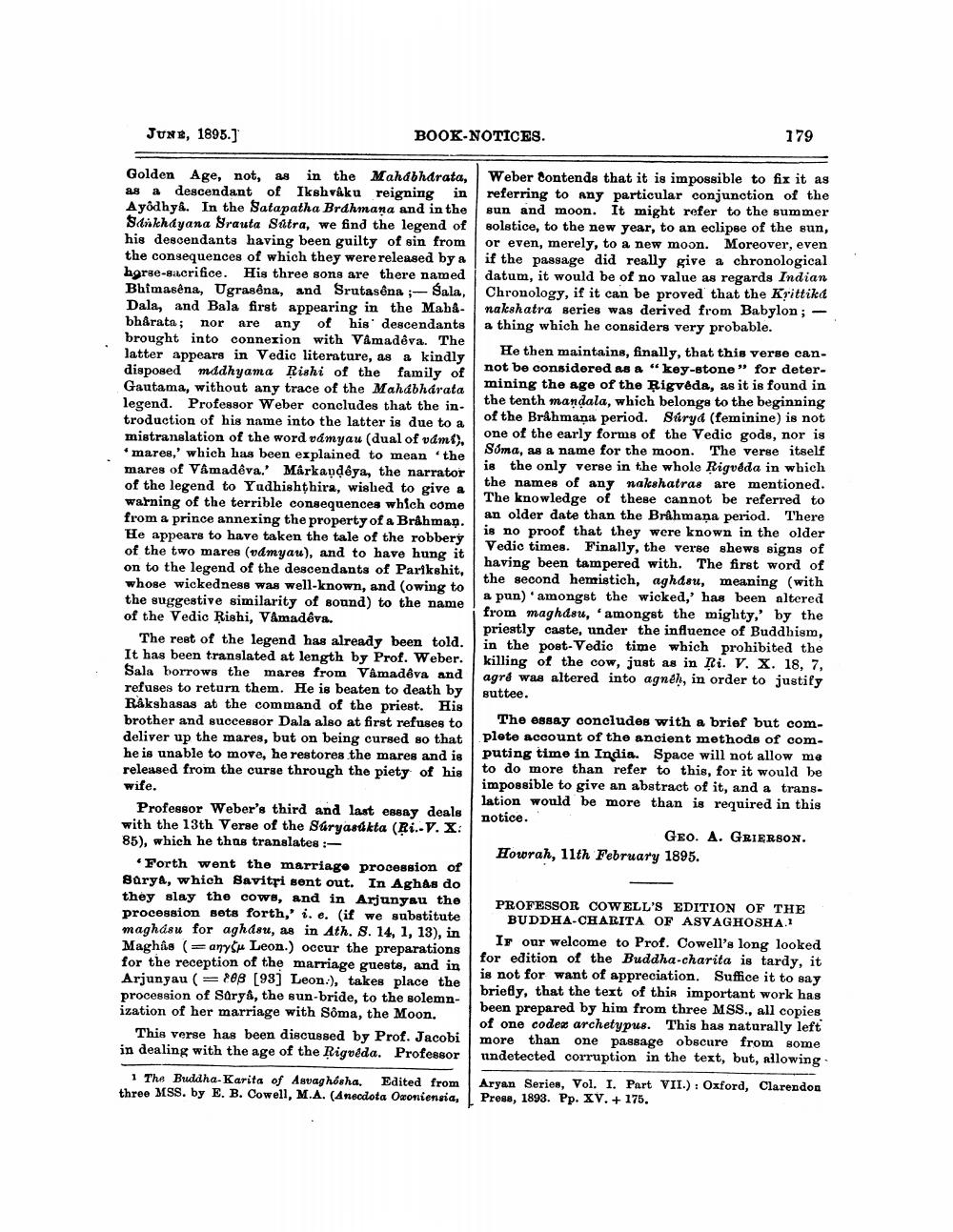________________
JUNE, 1895.]
BOOK-NOTICES.
179
Golden Age, not, as in the Mahabharata, Weber contends that it is impossible to fix it as as a descendant of Ikehvaku reigning in referring to any particular conjunction of the Ayodhy. In the Satapatha Brdhmana and in the sun and moon. It might refer to the summer Sikhayana Srauta Satra, we find the legend of solstice, to the new year, to an eclipse of the sun, his descendants having been guilty of sin from or even, merely, to a new moon. Moreover, even the consequences of which they were released by a if the passage did really give a chronological horse-sacrifice. His three sons are there named datum, it would be of no value as regards Indian Bhimasena, Ugrasêna, and Srutasôna ;-Sala, Chronology, if it can be proved that the Kșittikt Dala, and Bala first appearing in the Maba- nakshatra series was derived from Babylon; - bharata; nor are any of his descendants a thing which he considers very probable. brought into connexion with Vamadêva. The latter appears in Vedic literature, as a kindly
He then maintains, finally, that this verse candisposed mddhyama Rishi of the family of
not be considered as a "key-stone" for deterGautama, without any trace of the Mahabharata
mining the age of the Rigveda, as it is found in legend. Professor Weber concludes that the in
the tenth mandala, which belongs to the beginning troduction of his name into the latter is due to a
of the Brahmana period. Sürya (feminine) is not mistranslation of the word vámyau (dual of vdmt).
one of the early forms of the Vedic gode, nor is * mares,' which has been explained to mean the
Soma, as a name for the moon. The verse itself mares of Vamadêva. Márkayd@ya, the narrator
is the only verse in the whole Rigveda in which of the legend to Yudhishthira, wished to give a
the names of any nakshatras are mentioned. warning of the terrible consequences which come
The knowledge of these cannot be referred to from a prince annexing the property of a Brahman.
an older date than the Brahmana period. There He appears to have taken the tale of the robbery
is no proof that they were known in the older of the two mares (vdmyau), and to have hung it
Vedio times. Finally, the verse shews signs of on to the legend of the descendants of Parikshit,
having been tampered with. The first word of whose wickedness was well-known, and (owing to
the second hemistich, aghdsu, meaning (with the suggestive similarity of sound) to the name
a pun)' amongst the wicked,' has been altered of the Vedic Rishi, Vámadêva.
from maghdsu, amongst the mighty,' by the
priestly caste, under the influence of Buddhism, The rest of the legend has already been told. in the post-Vedio time which prohibited the It has been translated at length by Prof. Weber. killing of the cow, just as in Ri. V. X. 18, 7, Sala borrows the mares from Amadova and
agrd was altered into agneh, in order to justify refuses to return them. He is beaten to death by
Buttee. Rakshasas at the command of the priest. His brother and successor Dala also at first refuses to
The essay concludes with a brief but comdeliver up the mares, but on being cursed so that plete account of the ancient methods of comhe is unable to move, he restores the mares and is puting time in India. Space will not allow me released from the curse through the piety of his
to do more than refer to this, for it would be wife.
impossible to give an abstract of it, and a transProfessor Weber's third and last essay deals
lation would be more than is required in this with the 13th Verse of the Suryasúkta (Bi..V. X:
notice.
GEO. A. GRIERSON. 85), which he thus translates :
Howrah, 11th February 1895. Torth went the marriage procession of Barya, which Savitri sent out. In Aghas do they slay the cows, and in Arjunyau the
PROFESSOR COWELL'S EDITION OF THE procession sets forth,' i. e. (if we substitute BUDDHA-CHARITA OF ASVAGHOSHA.1 maghdsu for aghdsut, as in Ath. 8. 14, 1, 13), in
IF our welcome to Prof. Cowell's long looked Maghas (= anysu Leon.) occur the preparations for the reception of the marriage guests, and in
for edition of the Buddha-charita is tardy, it Arjunyau (=tes [93] Leon.), takes place the
is not for want of appreciation. Suffice it to say procession of Sürya, the sun-bride, to the solemn
briefly, that the text of this important work has ization of her marriage with Sôma, the Moon.
been prepared by him from three MSS., all copies
of one codex archetypus. This has naturally left This verse has been discussed by Prof. Jacobi more than one passage obscure from some in dealing with the age of the Rigveda. Professor undetected corruption in the text, but, allowing
1 The Buddha-Karita of Asvaghosha. Edited from Aryan Series, Vol. I. Part VII.): Oxford, Clarendon three MSS. by E. B. Cowell, M.A. (Anecdota Oxoniensia, Press, 1893. Pp. XV. + 175.




